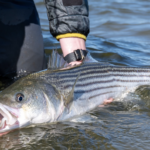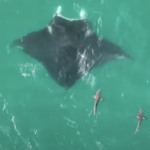
Talkin’ Striped Bass Spawn Dynamics
Consistent spawning production is paramount to a fishery’s long-term health. Many environmental factors are suspected
Progress for a globally-renowned fishery is under attack once again. After a lengthy stretch of community engagement, heated meetings and backdoor antics, it appeared that the latest Louisiana redfish NOI was only days away from becoming regulations. Now this same NOI, seen by many as a comprise between opposing agendas, is headed back to the Commission and the 30-day Oversight window has been paused.
Louisiana anglers, now is the time to raise your voices for the future of your red drum fishery.
CONTACT YOUR COMMISSIONERS:
Listed below are is the Commissioner contact list for the current Louisiana Wildlife & Fisheries Commission. These seven individuals will make the decision on the current redfish NOI. After reading this blog, we highly encourage Louisiana anglers to contact your commissioners and urge them to pass the current redfish NOI with a 3-fish limit.
Chair: Mr. Brandon DeCuir (decuirbj@gmail.com)
Vice-Chair: Mr. Harlie E. Reynolds (hegenereynolds@gmail.com)
Mr. Andy Brister (andy.brister@gmail.com)
Mr. Kevin Sagrera (kevinsag1@bellsouth.net)
Mr. Andrew Blanchard (andrew@pearlbrandseafood.com)
Mr. Wendell Luneau, Jr. (luneauwendell@gmail.com)
Mr. Nathan Wall (nathan@wallsgatorfarm.com)
THE CURRENT SITUATION:
It may be the end of February, but it appears we are still living through Groundhog Day. Redfish regulations in Louisiana are going back to the state commission for a fourth time. We started to hear rumblings late last week that the “compromise” redfish Notice of Intent, which was very close to becoming law, would be suspended in the legislature so the Louisiana Wildlife and Fisheries Commission could take up new considerations at their March meeting.
We were left wondering how this could happen. The history of this management action is important to the overall discussion. Back in late 2022, Louisiana Department of Wildlife and Fish (LDWF) completed the first stock assessment in decades for the state’s most important fish. It showed some very disturbing facts about the health of the stock:
In 1999, there were 23 million redfish in Louisiana. In 2021, the last year of data from the assessment, there were 8.7 million. The is over a 60% drop in population.This rang alarm bells throughout the state. We respect LDWF and their team of biologists. The stock assessment is comprehensive, peer reviewed and gives us the data we need to manage this fishery properly. LDWF also provided stock projections for redfish that showed how different regulations would impact the rebuilding timeline.
LDWF came out in support of a 35% reduction right after the assessment. That wasn’t a reflection of what they wanted. It was a reflection of what they thought would pass. The state agency was embroiled in changes to speckled trout regulations for years. The trout stock assessment came out before the pandemic. To be fair, that slowed the process down on its own. But there was also pushback from recreational angler groups to oppose trout conservation.
LDWF and other stakeholders tried in vain for years to change the 25 fish limit on trout. Based on their recent experience, LDWF opted for the bare minimum reductions on redfish. We don’t blame them. While it’s sad they felt this was the only viable option in this environment, they just wanted to get something done. That’s when our guides and many other passionate, thoughtful local skateholders rolled up their sleeves. LDWF went on record supporting more conservation. You can see this in the video transcripts of Commission and legislative meetings.
Redfish are managed on a 30% Escapement Rate (ER). ER is the metric that informs us on how many juvenile redfish make it to adulthood. Redfish can achieve the ER if 30 out of 100 recruit. Surely 300,000 out of a million would be a much better outcome. This is critical to understand because there is a stock/recruitment relationship with redfish. It does matter how many adults are in the system. 30% of 15 million is a lot better than 30% of 150,000 for the future of the fishery.
This is why ASGA focused so much on Spawning Potential Ratio (SPR) as part of our policy platform. For you striped bass anglers out there, this is very similar to the striper metric of Spawning Stock Biomass (SSB). It is an indicator of the health of the adult population. This creates the potential for incredible spawns for redfish.
Take a look at these tables from the stock assessment projections below:


The first notable fact to point out is that we are in 2024. These projections are based on data ending in 2021. That means Louisiana has been fishing under the same regulations and you can bet that the stock has experienced the same trends that the latest assessment shows. In other words, there is a good likelihood that these projections are off a little off “for worse” due to fishing mortality in 2022 and 2023.
The original position from LDWF (the bare minimum) would have brought the ER back to 30% in five years. It would bring SPR back to target in 29 years.
At the Commission meeting in July, our guides pushed hard for a 55% reduction to bring SPR back to target in about 13 years. ER would have been back to target in only three years. You may be asking yourself how are the percentages worked out in real life regulations? Take a look at these charts from the assessment. These are the regulations (slot size x total) and resulting reductions. Note that all regulations include no overslot fish harvest and no guide limits allowed.

Here’s an excellent chart depicting the percentage reduction and the impact on the health of the stock. A 30% reduction never brings SPR or Escapement back to target. That’s why 35% was the bare minimum. Louisiana is betting on fish that haven’t been born. That is a horrible decision for such a vital part of the state’s economy.

The difference between a 30-year rebuilding timeline and a 13 year timeline is one fish and 3 inches off the slot. 35% is 4 fish with and 18-27” limit. Our proposal was 3 fish and an 18-24” slot. While others may be attempting to craft the narrative, this is not a tectonic shift from the “bare minimum”.
In July, the proposal our guides pushed for was accepted at the commission meeting. The original NOI was amended and that started a public comment period. Our community went into high gear and signed our letter of support in staggering numbers. This set the stage for a battle royale at the October commission meeting. We sent in more comments. We dominated the discussion. However, there was foul play afoot. Redfish were listed on the agenda as an “action item” rather than just an agenda item. This opened the door for a commission member to move to amend the NOI without so much as a discussion about the public comments. Ultimately, another commissioner questioned the “action item” designation and there were some embarrassed people in the room. The “back-room antics” were discovered and stopped… for the moment.
Our NOI was sent to the legislative Oversight Committee. This starts the clock on a 30-day window to call a hearing. If a hearing isn’t called, the NOI becomes a regulation. So, we made calls, sent emails and worked every day to stay in the loop. The hearing was called, and we showed up in force. The decision was made before any of us stepped into the room. We lost. It hurt.
Following the process, the NOI was sent back to the commission in December 2023 and a compromise was required. Our guides presented 3 fish at 18-27”, expanding the confines of the slot with hopes of meeting in the middle. This was accepted again. Now the new NOI goes back to the Joint Oversight Committee.
By the end of January, our compromise NOI sat with the same people that rejected the previous NOI. We made the calls. We sent the emails. We stayed in touch every day. As each day passed in February, we knew we were getting closer and closer to redfish having a brighter future. Everything we heard said that the Oversight Committee had no appetite for a hearing this time. We stayed in the loop knowing that history tends to repeat itself. Once again, antics are afoot.
We found out on Thursday, as time was running out, that the NOI was going back to the commission at the request of the new Chairman and the 30-day timeline was going to be suspended at the legislature.
Here we go again.
The fascinating thing in all of this mess is that in parallel to true redfish conservation, there was also a push to have a one-mile buffer zone on menhaden. ASGA submitted a letter of support for this action. The buffer zone was watered down to just half a mile. Truth be told, there was already a ¼ mile buffer zone – so we are talking about adding 1500 feet to the existing rule. Many groups applauded this as the action that would save redfish. Yet, these same groups are either silent or the architects of the backroom antics that we have fought back no less than three times. How can you save redfish by moving a line 1500 feet and two weeks later actively work towards killing more redfish? This is a rhetorical question.
On March 7th, 2024, we will be at the Commission again ready and willing to point out the hypocrisy and arrogance that directly threatens the future of an iconic fishery. We will ask the commissioners if they want to risk the next generation of young anglers being unable to experience what Louisiana used to be. Progress isn’t linear. It’s messy, sometimes confusing and requires the utmost courage and commitment to create. We are committed and we hope you’ll be there every step of the way with us.
THE STATE OF THE FISHERY:
While the stock isn’t currently overfished, recruitment/ how many juveniles make it to adulthood, is at the lowest levels observed and has been declining since 1994.
Recreational landings for the entire state are the lowest recorded since the 1980’s. While some areas are doing OK, most are not. It won’t be long until a majority of areas are experiencing poor fishing. Taking the bare minimum management response puts the entire redfish angling economy at risk.
The Louisiana redfish population peaked at an estimated 23+ million fish in 1999. We are now at an estimated 8.7 million fish. That represents a 60% decrease in abundance.
In eight of the last ten years, we have removed more fish than have been replaced. In the last decade, redfish had the lowest recruitment on record. We need big fish to make little fish. With the lowest recruitment on record, using a 30% escapement rate rather than a spawning potential ratio may be a bad policy. Remember, “30% of nothing is still nothing.”
There is no other management body in the country that would accept a 30-year plan to get back to target. A timeline with that level of uncertainty is a recipe for disaster. After ten years, projections become very inaccurate. At 30 years, it is nothing more than a guess. This iconic fishery and the next generation of Louisiana sportsmen deserve more effort than “a guess”.
LDWF supported more conservation at this commission and in the legislature. We all heard it. Saying anything different is not accurate. Public comment is overwhelmingly in support of more conservation. For many guides, anglers and business owners, this hearing on March 7th will be the fourth time they have attended to speak on the topic. At the last Oversight Committee Hearing, there were talks about finding a compromise. The current NOI is the “compromise”. There is nothing more to change.
ADDITIONAL RESOURCES:
THE GUIDE POST PODCAST
Glen ‘Catch’ Cormier has decades of fly fishing experience. He’s a certified casting instructor and a long-time Louisiana resident. In our latest episode, Catch stops by The Guide Post to break down the redfish management conundrum currently playing out in Louisiana. You can listen to this episode on Apple Podcast, Spotify or in your preferred browser by clicking below.
LOUISIANA REDFISH STOCK ASSESSMENT
Tony Friedrich of the American Saltwater Guides Association breaks down Louisiana’s latest Redfish Stock Assessment.

Consistent spawning production is paramount to a fishery’s long-term health. Many environmental factors are suspected

While the ASGA team is extremely proud of the community we’re building with the Guide

Feature Image: A false albacore being landed off Jupiter Florida by the Cheeky Fishing team,

Feature Photo: “Best Practices for Fishing Cobia Around Manta Rays” The Florida Manta Project is
We rely on our members and donations to keep fighting for a sustainable tomorrow in marine conservation.
By using this website, you agree to our use of cookies. We use cookies to provide you with a great experience and to help our website run effectively. To learn more, please review our privacy policy.